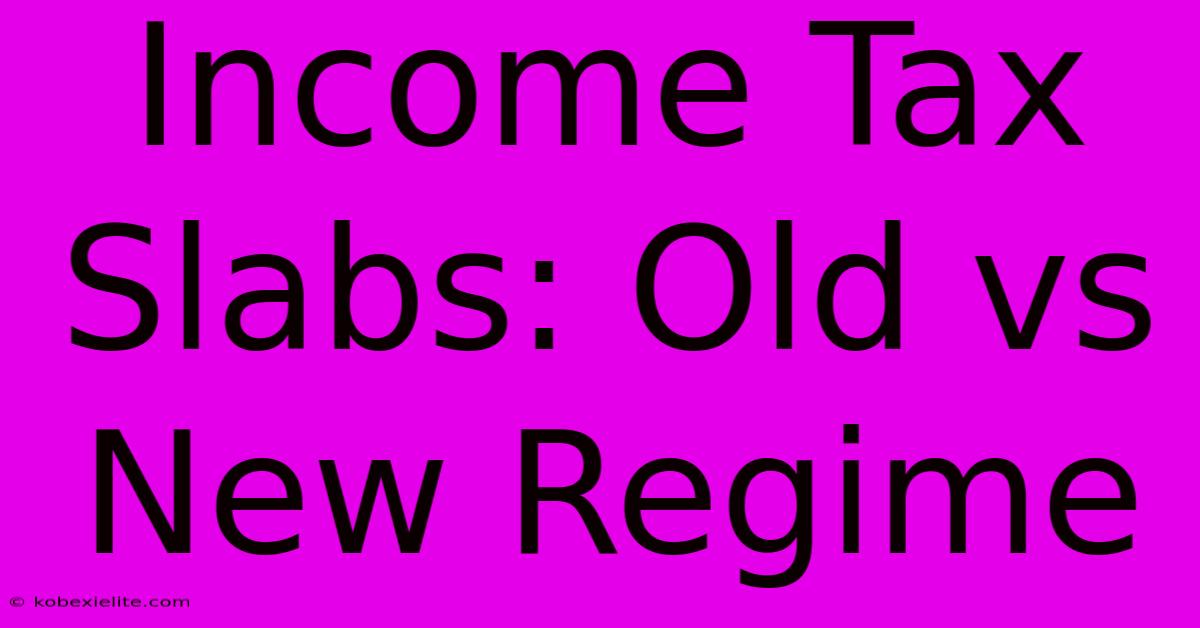Income Tax Slabs: Old Vs New Regime

Discover more detailed and exciting information on our website. Click the link below to start your adventure: Visit Best Website mr.cleine.com. Don't miss out!
Table of Contents
Income Tax Slabs: Old vs New Regime – Which One Suits You Best?
Choosing the right income tax regime can significantly impact your annual tax liability. India offers two distinct regimes: the old and the new tax regime. Understanding the differences between them is crucial for optimizing your tax planning. This comprehensive guide breaks down the old and new income tax slabs, highlighting key differences to help you determine which regime best suits your financial situation.
Understanding the Indian Income Tax System
Before diving into the specifics, let's establish a basic understanding. The Indian income tax system operates on a progressive taxation model, meaning higher income brackets face higher tax rates. Both the old and new regimes utilize this principle, but with different slab structures and exemptions.
Old Tax Regime: A Familiar Framework
The old tax regime is the traditional system many taxpayers are familiar with. It offers a range of deductions and exemptions that can significantly reduce your taxable income. However, navigating these deductions can be complex.
Old Regime Tax Slabs (for FY 2023-24, AY 2024-25):
| Income Slab (in ₹) | Tax Rate |
|---|---|
| Up to 2.5 Lakhs | 0% |
| 2.5 Lakhs – 5 Lakhs | 5% |
| 5 Lakhs – 10 Lakhs | 20% |
| Above 10 Lakhs | 30% |
Key Features of the Old Regime:
- Numerous Deductions: This regime allows for various deductions under sections like 80C (investments), 80D (health insurance), 80TTA (interest on savings account), and more. These deductions can substantially lower your taxable income.
- Complexity: The multitude of deductions makes the old regime comparatively complex to understand and utilize effectively.
- Suitable for: Taxpayers with substantial eligible investments and deductions.
New Tax Regime: Simplicity and Predictability
Introduced to simplify tax calculations, the new tax regime offers a straightforward structure with fewer deductions. While it lacks the extensive deductions of the old regime, its simplicity is a major advantage.
New Regime Tax Slabs (for FY 2023-24, AY 2024-25):
| Income Slab (in ₹) | Tax Rate |
|---|---|
| Up to 3 Lakhs | 0% |
| 3 Lakhs – 6 Lakhs | 5% |
| 6 Lakhs – 9 Lakhs | 10% |
| 9 Lakhs – 12 Lakhs | 15% |
| 12 Lakhs – 15 Lakhs | 20% |
| Above 15 Lakhs | 30% |
Key Features of the New Regime:
- Simplified Structure: Fewer deductions translate to easier tax calculations and filing.
- Predictability: Tax liability is more predictable as it primarily relies on your gross income.
- Suitable for: Taxpayers with fewer eligible investments and deductions, or those who value simplicity over potential tax savings from deductions.
Old vs. New Regime: A Comparative Analysis
| Feature | Old Regime | New Regime |
|---|---|---|
| Complexity | High | Low |
| Deductions | Many | Few |
| Tax Slabs | Lower starting slab, higher tax rates for higher incomes | Higher starting slab, lower tax rates for higher incomes |
| Suitability | Individuals with significant eligible investments and deductions | Individuals with fewer investments and deductions, those prioritizing simplicity |
Choosing the Right Regime for You
The optimal regime depends entirely on your individual financial circumstances. It's crucial to calculate your tax liability under both regimes using your specific income and deductions before making a decision. You can use online tax calculators or consult a tax professional to determine which regime offers you the lowest tax burden.
Consider these factors:
- Your Income: Higher income earners might find the new regime more beneficial, while lower income earners may benefit from the deductions in the old regime.
- Your Investments and Deductions: The availability of eligible investments and deductions significantly impacts the old regime's effectiveness.
- Your Risk Tolerance: The simplicity of the new regime comes at the cost of potentially missing out on deductions.
Disclaimer: This article provides general information and should not be considered financial or tax advice. Always consult with a qualified tax professional for personalized advice based on your specific circumstances. Tax laws are subject to change, so it’s essential to stay updated.

Thank you for visiting our website wich cover about Income Tax Slabs: Old Vs New Regime. We hope the information provided has been useful to you. Feel free to contact us if you have any questions or need further assistance. See you next time and dont miss to bookmark.
Featured Posts
-
Pebble Beach Mc Ilroys Back Nine Surge
Feb 03, 2025
-
Durant Comments On Doncic Trade
Feb 03, 2025
-
Loan Deal Rashford Leaves Manchester United
Feb 03, 2025
-
Wwe Rumble 2025 Results Updates
Feb 03, 2025
-
Milan Inter Derby Predicted Lineups
Feb 03, 2025
